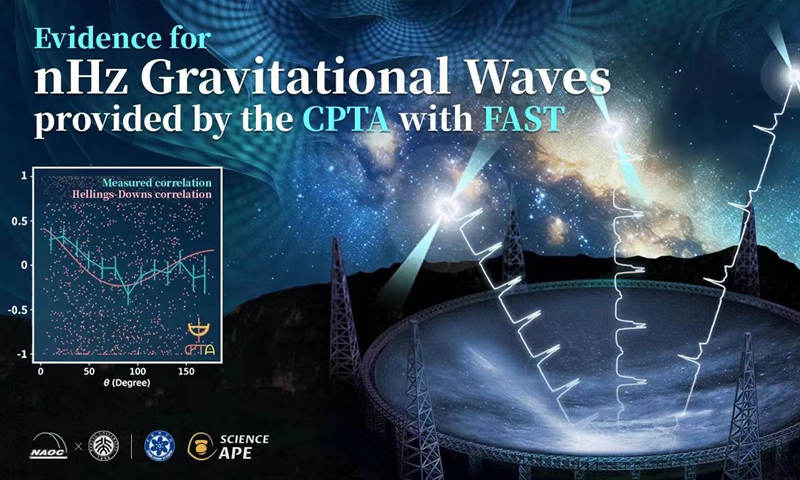Chinese scientists find key evidence for existence of nanohertz gravitational waves

A group of Chinese scientists have recently discovered key evidence supporting the existence of nanohertz gravitational waves, marking a new era in nanohertz gravitational wave research. The findings have been published online in the academic journal Research in Astronomy and Astrophysics (RAA) on Thursday, the Global Times learned from the National Astronomical Observatories of the Chinese Academy of Sciences (NAOC).
The research was based on pulsar timing observations carried out with the Five hundred-meter Aperture Spherical radio Telescope (FAST), known as China's Tianyan or Sky Eye. It is conducted by the Chinese Pulsar Timing Array (CPTA) collaboration that comprises researchers from the NAOC and other institutes, according to a press release from the NAOC.
The acceleration of massive objects disturbs the surrounding space-time and produces "ripples," known as gravitational waves. Although such wave signals are extremely weak, they offer a direct method for probing masses that do not emit light, Li Kejia, a Professor at NAOC and Department of Astronomy and Kavli Institute for Astronomy and Astrophysics at Peking University who is also member of the team, explained at a press conference on the team's findings on Tuesday.
For this reason, astronomers have long aimed to use gravitational waves to aid in understanding the formation of the Universe's structures and investigating the growth, evolution, and merger of the most massive celestial objects in the Universe that is supermassive black holes. Such research will also help physicists gain insight into the fundamental physical laws of space-time, according to Li.
Taking advantage of FAST's high sensitivity, the CPTA research team monitored 57 millisecond pulsars with regular cadence for 41 months. The team found key evidence for quadrupole correlation signatures compatible with the prediction of nanohertz gravitational waves at a 4.6-sigma statistical confidence level (with a false alarm probability of two in a million), Li said.
The time span of CPTA data set is relative short at present. However, due to the high sensitivity of FAST telescope, CPTA achieved similar sensitivity comparing to other PTAs. The future observations will soon extend the span of CPTA data and help in identifying the astronomical sources of current signal, read the NAOC release.
The detection of nanohertz gravitational waves is very challenging due to their extremely low frequency, with corresponding periods that can last several years and wavelengths spanning several light-years. So far, the only known effective method for detecting nanohertz gravitational waves is through long-term timing observation of millisecond pulsars with extreme rotational stability.
The CPTA research team used independently developed data analysis software and data processing algorithms to achieve its breakthrough at the same time as other international groups. Independent data processing pipelines produced compatible results, proving China's rapid development in the field, experts said.
Hunting for these waves is one of the major focuses of present-day physics and astronomy research. Regional pulsar timing array collaborations, including the North American Nanohertz Observatory for Gravitational Waves (NANOGrav), the European Pulsar Timing Array(EPTA), and the Australian Parkes Pulsar Timing Array (PPTA), have been collecting pulsar timing data for more than 20 years, with the aim of detecting nanohertz gravitational waves. Recently, several new regional collaborations have also entered this field, including CPTA, the India Pulsar Timing Array (InPTA), and the South Africa Pulsar Timing Array (SAPTA).
China kicked off preliminary research on pulsar timing array as early as in 2002. In September 2019 when FAST was still in the debugging stage, the CPTA team started trial observations in conjunction with the FAST engineering team in order to accumulate observation data for the detection of nanohertz gravitational waves as early as possible, according to the NAOC.
In the future, the NAOC said it will actively promote the expansion and upgrading of FAST, based on the pulsar timing array method, to realize the routine observation of nanohertz gravitational wave events, thereby building a nanohertz gravitational wave observatory, and opening up a new era of low-frequency radio with higher sensitivity and higher resolution.
Regional collaborations will also help promote international pulsar timing array collaboration and expand exploration of the Universe through nanohertz gravitational wave observations, according to the NAOC.